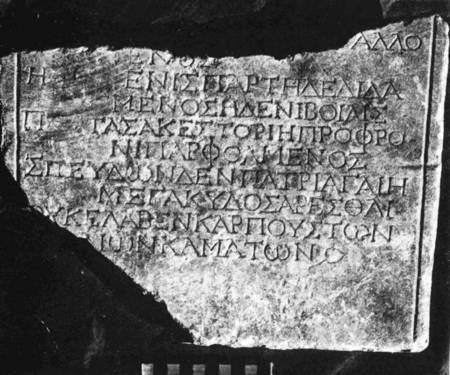Metrical Inscription - Medicine references - by, W.G. Forrest.

From:
Kythera: Excavations and Studies conducted by the University of Pennsylvania Museum and the British School at Athens.
J.N. Coldstream and G.L. Huxley (editors)
R. Hope Simpson, J.F. Lazenby and A.S. Trik,
with contributions from,
Bernard Anderson, W.G. Forrest, Judith Herrin, A.H.S. Megaw, and W.H. Plommer.
Faber and Faber Limited.
3 Queen Square, London.
1972.
Appendix B
A Metrical Inscription
by, W.G. Forrest.
During the excavations in Kythera in 1963, the following inscription was brought to the dig house by a workman. I have not seen the stone myself, and am grateful to Professor Huxley and Mr A Papadopoulos for many of the details.
Plaque of grey marble, broken off at top and bottom left corner.
H. (max.) ·266 m.,
W. ·34 m.,
Th. ·053
Letters, H. ·012 -·014 m.,
interl., ·004 m.
Two shallow channels have been cut at left and right to make margins ·012 wide. At the bottom there is an unmarked margin of ·065.
{For PC-users: To read the lines below in Greek (not including "hedera")
- copy this text from web-site
- paste to a word document on your computer
- convert the font to "Symbol".
The lines will then appear in Greek.
Repeat later - if you wish to read the text in Greek from Lucian's Apokritomenos.}
....................ag]allo [m]enoV
h[men] eni Sparth(i) dedida gmenoV hd eni BoiaiV
p[ant] aV akestorih(i) profro ni parfqanenoV.
opeudwn d en patria(i) gaih(i) mega kudoV aresqai,
ouk elaben karpoV twn [i]diwn kamatwn.
hedera
The lettering, which I should place in the second century A.D., is a little rough, but without some pretensions to elegance, and much the same may be said of the style and indeed of the sentiments. Note for example, the ambiguity, presumably deliberate, of the last line = 'the physician did not win the kudoV (kithos} for which he had hoped', but equally 'the physician could not heal himself'. Trite, but for Kythera, quite sophisticated.
This sad little story of the local boy who didn't make good is nicely paralleled in the career of Lucian's
ApokhruttomenoV (162): apodhmhsaV oun kai taiV endokimwtatoiV twn epi thV allodaphV iatrwn suggevomenoV kai ponw pollw kai proqumia liparei crhqamenoV exemaqon thn tecnhn. epavelqwn de katalambanw ton patera....upo twn epicwpiwn iatrwn apegnwsmenon ouk eV baqoV orwntwn.....
...I treated him...but after his cure....he had disowned me again.
The latter's fate was rather less drastic than the former's. But even if our Kytherian believed, as one feels he did, that Sparta and Boiai between them had provided the best of educations, one cannot help wondering what sort of medical studies could be practised in either. Both boasted temples of Asklepios (Boiai - Paus. 3.22.13; Sparta-Paus. 3.14.2; 14,7), but neither is known to have been much of a medical centre; most probably the Kytherian had merely attached himself to some local practioners in the standard way.
For medical education in general see I. E. Drabkin, Bulletin of the History of Medicine 15 (1944), pages 331-51.